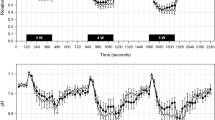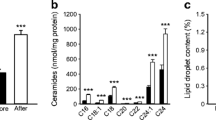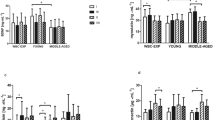Abstract
Skeletal muscle catabolism, low plasma glutamine, and high venous glutamate levels are common among patients with cancer or human immunodeficiency virus infection. In addition, a high glycolytic activity is commonly found in muscle tissue of cachectic cancer patients, suggesting insufficient mitochondrial energy metabolism. We therefore investigated (a) whether an “anaerobic physical exercise” program causes similar changes in plasma amino acid levels, and (b) whether low plasma glutamine or high glutamate levels are risk factors for loss of body cell mass (BCM) in healthy human subjects, i.e., in the absence of a tumor or virus infection. Longitudinal measurements from healthy subjects over longer periods suggest that the age-related loss of BCM occur mainly during episodes with high venous glutamate levels, indicative of decreased muscular transport activity for glutamate. A significant increase in venous glutamate levels from 25 to about 40 μM was seen after a program of “anaerobic physical exercise.” This was associated with changes in T lymphocyte numbers. Under these conditions persons with low baseline levels of plasma glutamine, arginine, and cystine levels also showed a loss of BCM. This loss of BCM was correlated not only with the amino acid levels at baseline examination, but also with an increase in plasma glutamine, arginine, and cystine levels during the observation period, suggesting that a loss of BCM in healthy individuals terminates itself by adjusting these amino acids to higher levels that stabilize BCM. To test a possible regulatory role of cysteine in this context we determined the effect of N-acetyl-cysteine on BCM in a group of subjects with relatively low glutamine levels. The placebo group of this study showed a loss of BCM and an increase in body fat, suggesting that body protein had been converted into other forms of chemical energy. The decrease in mean BCM/body fat ratios was prevented by N-acetyl-cysteine, indicating that cysteine indeed plays a regulatory role in the physiological control of BCM.
Similar content being viewed by others
Abbreviations
- BCM :
-
Body cell mass
- HIV :
-
Human immunodeficiency virus type 1
- NAC :
-
N-Acetyl-cysteine
References
Pisters PW, Pearlstone DB (1993) Protein and amino acid metabolism in cancer cachexia: investigative techniques and therapeutic interventions. Crit Rev in Clin Lab Sciences 30:223–272
Brennan MF (1986) Malnutrition in patients with gastrointestinal malignancy. Significance and management. Dig Dis Sci 31:77S-90S
Strain AJ (1979) Cancer cachexia in man. A review. Invest Cell Pathol 2:181–193
DeWys WD, Begg C, Lavin PT et al (1980) Prognostic effect of weight loss prior to chemotherapy in cancer patients. Am J Med 69:491–497
Grunfeld C (1991) Mechanisms of wasting in infection and cancer: an approach to cachexia in AIDS. In: Kotler DP (ed) Gastrointestinal and nutritional manisfestions of AIDS. Raven, New York, pp 207–229
Kotler DP, Wang J, Pierson R (1985) Body composition in patients with the acquired immunodeficiency syndrome. Am J Clin Nutr 42:1255–1265
Brennan MF (1977) Uncomplicated starvation versus cancer cachexia. Cancer Res 37:2359–2364
Long CL, Crosby F, Geiger JW, Kinney JM (1976) Parenteral nutrition in the septic patient: nitrogen balance, limiting plasma amino acids, and calorie to nitrogen ratios. Am J Clin Nutr 29:380–391
Fein R, Kelsen DP, Geller N (1985) Adenocarcinoma of the esophagus and gastroesophageal junction: prognostic factors and results of therapy. Cancer 56:2512–2518
Warren S (1932) The immediate causes of death in cancer. Am J Med Sci 184:610–615
Harnett WL (1952) A survey of cancer in London. British Empire Cancer Campaign
Lawson DH, Richmond A, Nixon DW, Rudman D (1982) Metabolic approaches to cancer cachexia. Annu Rev Nutr. 2:277–301
Friedman PJ (1987) Is wasting itself lethal? A case-control prospective study. Nutr Res 7:707–717
Waterhouse C, Jeanpretre N, Kielson J (1968) Gluconeogenesis from alanine in patients with progressive malignant disease. Cancer Res 39: (1968)
Shaw JH, Wolfe RR (1987) Glucose and urea kinetics in patients with early and advanced gastrointestinal cancer: the response to glucose infusion and TPN Surgery 101:181–186
Shaw JHF, Klein S, Wolfe RR (1985) Assessment of alanine, urea and glucose interrelationships in normal subjects and in patients with sepsis using stable isotopic tracers. Surgery 97:557–567
Aoki T, Muller WA, Cahill GF (1972) Hormonal regulation of glutamine metabolism in fasting man. Adv Enzyme Regul 10:145–151
Owen OE, Felig P, Morgan AP, Wahren J, Cahill GF (1969) Liver and kidney metabolism during prolonged starvation. J Clin Invest 48:584–594
Burt ME, Aoki TT, Gorschboth CM, Brennan MF (1983) Peripheral tissue metabolism in cancer-bearing man. Ann Surg 198:685–691
Striebel J-P, Saeger H-D, Ritz R, Leweling H, Holm E (1986) Aminosäureaufnahme und -abgabe kolorektaler Karzinome des Menschen. Infusionsther 13:92–104
Zhang PC, Pang CP (1992) Plasma amino acid patterns in cancer. Clin Chem 38:1198–1199
Dröge W, Groß A, Hack V, Kinscherf R, Schykowski M, Bockstette M, Mihm S, Galter D Role of cysteine and glutathione in HIV infection and cancer cachexia. — Therapeutic intervention with N-acetyl-cysteine (NAC). In: “Antioxidants in disease mechanisms and therapeutic strategies” (Sies H, ed.) Adv. Pharmacol, Acad Press, 1996 (in press)
Dröge W, Eck H-P, Näher H, Pekar U, Daniel V (1988) Abnormal amino acid concentrations in the blood of patients with acquired immune deficiency syndrome (AIDS) may contribute to the immunological defect. Biol Chem Hoppe-Seyler 369:143–148
Hortin GL, Landt M, Powderly WG (1994) Changes in plasma amino acid concentrations in response to HIV-1 infection. Clin Chem 40:785–789
Roth E, Mühlbacher F, Karner J, Steininger R, Schemper M, Funovics, J (1985) Liver amino acids in sepsis. Surgery 97:436–442
Siegel JH, Cerra FB, Coleman B et al (1979) Physiological and metabolic correlations in human sepsis. Surgery 86:163–192
Cerra FB, Siegel JH, Coleman B (1980) Septic autocannibalism: a failure of exogenous nutritional support. Ann Surg 192:570–574
Roth E, Funovics J, Mühlbacher F, Schemper M, Mauritz W, Sporn P, Fritsch A (1982) Metabolic disorders in severe abdominal sepsis: glutamine deficiency in skeletal muscle. Clin Nutr. 1:25–41
Klimberg VS, Souba WW, Salloum RM et al (1990) Glutamine-enriched diets support muscle glutamine metabolism without stimulating tumor growth. J Surg Res 48:319–323
Scheltinga MR, Young LS, Benfell K, Bye RL, Ziegler TR, Santos AA, Antin JH, Schloerb PR, Wilmore DW (1991) Glutamine-enriched intravenous feedings attenuate extracellular fluid expansion after a standard stress. Ann Surg 214:385–395
Stehle P, Mertes N, Puchstein Ch, Zander J, Albers S, Lawin P (1989) Effect of parenteral glutamine peptide supplements on muscle glutamine loss and nitrogen balance after major surgery. Lancet I:231–233
Hammarqvist F, Wernerman J, Ali R, von der Decken A, Vinnars E (1989) Addition of glutamine to total parenteral nutrition after elective abdominal surgery spares free glutamine in muscle, counteracts the fall in muscle protein synthesis, and improves nitrogen balance. Ann Surg 209:455–461
Roth E, Karner J, Ollenschläger G, Karner J, Simmel A, Fürst P, Funovics J (1988) Alanylglutamine reduces muscle loss of alanine and glutamine in post-operative anaesthetized dogs. Clin Science 75:641–648
Tayek JA (1992) A review of cancer cachexia and abnormal glucose metabolism in humans with cancer. J Am Col Nutr. 11:445–456
Wilmore DW, Aulick LH (1978) Metabolic changes in burned patients. Surg Clin North Am 58:1173–1187
Roth E (1985) Untersuchungen zum Aminosäuren- und Proteinstoffwechsel bei kritisch Kranken. Infusionstherapie 12:270–280
Eck H-P, Drings P, Droge W (1989) Plasma glutamate levels, lymphocyte reactivity and death rate in patients with bronchial carcinoma. J Cancer Clin Oncol 115:571–574
Eck H-P, Stahl-Hennig C, Hunsmann G, Dröge W (1991) Metabolic disorder as an early consequence of simian immunodeficiency virus infection in rhesus macaques. Lancet 338:346–347
Plaitakis A, Caroscio JT (1987) Abnormal glutamate metabolism in amyotrophic lateral sclerosis. Ann Neurol 22:575–579
Hack V, Stütz O, Kinscherf R, Schykowski M, Kellerer M, Holm E, Droge W (1996) Elevated venous glutamate levels in (pre)catabolic conditions result at least partly from a decreased glutamate transport activity. J Mol Med 74:337–343
Lukaski HC (1987) Methods for the assessment of human body composition: traditional and new. Am J Clin Nutr 46:537–556
Ott M, Lembcke B, Fischer H, Jäger R, Polat H, Geier H, Rech M, Staszeswki S, Helm EB, Caspary W (1993) Early changes of body composition in human immunodeficiency virus-infected patients: tetrapolar body impedance analysis indicates significant malnutrition. Am J Clin Nutr 57:15–19
Askanazi J, Carpentier YA, Michelsen CB, Elwyn DH, Fürst P, Kantrowitz LR, Gump FE, Kinney JM (1980) Muscle and plasma amino acids following injury. Ann Surg 192:78–85
Fürst P, Bergström J, Chao L, Larsson J, Liljedahl S-O, Neuhäuser M, Schildt B, Vinnars E (1979) Influence of amino acid supply on nitrogen and amino acid metabolism in severe trauma. Acta Chir Scand Suppl 494:136
Barbul A (1986) Arginine: biochemistry, physiology and therapeutic implications. J Parent Ent Nutr 10:227–238
Daly JM, Reynolds JV, Thom A, Kinsley L, Dietrick-Gallagher M, Shou J, Ruggieri B (1988) Immune and metabolic effects of arginine in the surgical patient. Ann Surg 208:512–523
Kretschmar M, Müller D (1993) Aging, training and exercise. A review of effects on plasma glutathione and lipid peroxides. Sports Med 15:196–209
Häussinger D, Gerok W (1985) Hepatic urea synthesis and pH regulation. Role of CO2, HCO3−, pH and the activity of carbonic anhydrase. Eur J Biochem 152:381–386
Süttmann U, Hoogestraat L, Ockenga J, Coldewey R, Schedel I, Deicher H, Müller MJ (1991) Ernährungszustand und Immundefekt bei Patienten mit HIV-1-Infektion. Infusionstherapie 18:72–73
Süttmann U, Ockenga J, Seiberg O, Hoogestraat L, Deicher H, Muller, MJ (1995) Incidence and prognostic value of malnutrition and wasting in human immunodeficiency virus-infected outpatients. J Acquir Immune Defic Syndr. Hum Retrovirol 8:239–246
Noakes TD (1986) The lore of running. Cape Town, Oxford University Press
Author information
Authors and Affiliations
Rights and permissions
About this article
Cite this article
Kinscherf, R., Hack, V., Fischbach, T. et al. Low plasma glutamine in combination with high glutamate levels indicate risk for loss of body cell mass in healthy individuals: the effect of N-acetyl-cysteine. J Mol Med 74, 393–400 (1996). https://doi.org/10.1007/BF00210633
Received:
Accepted:
Issue Date:
DOI: https://doi.org/10.1007/BF00210633




